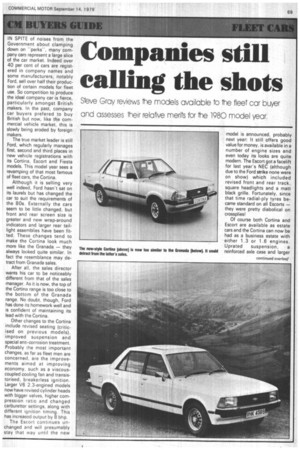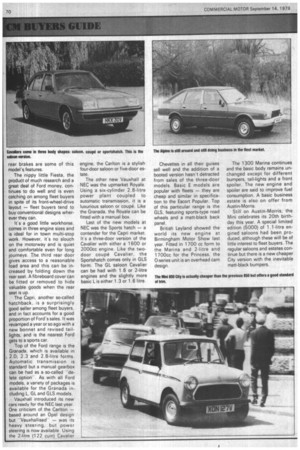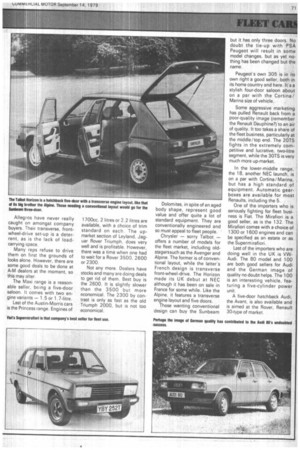Companies still calling the shots
Page 71

Page 72

Page 73

If you've noticed an error in this article please click here to report it so we can fix it.
Steve Gray reviews the models available to the fleet car buyer and assesses eir relative merits for the 1980 model year,
IN SPITE of noises from the Government about clamping
down on -perks-, many com
pany cars represent a large slice of the car market. Indeed over 40 per cent of cars are regist ered in company names and some manufacturers, notably Ford, sell over half their produc tion of certain models for fleet use. So competition to produce the ideal company car is fierce, particularly amongst British makers. In the past, company car buyers prefered to buy British but now, like the commercial vehicle market, this is slowly being eroded by foreign makers.
The true market leader is still Ford, which regularly manages first, second and third places in new vehicle registrations with its Cortina, Escort and Fiesta models. This model year sees a revamping of that most famous of fleet cars, the Cortina.
Although it is selling very well indeed, Ford hasn't sat on its laurels but has changed the car to suit the requirements of the 80s. Externally the cars seem to be little changed, but front and rear screen size is greater and new wrap-around indicators and larger rear taillight assemblies have been fitted. These changes tend to make the Cortina look much more like the Granada — they always looked quite similar. In fact the resemblance may detract from Granada sales.
After all, the sales director wants his car to be noticeably different from that of the sales manager. As it is now, the top of the Cortina range is too close to the bottom of the Granada range. No doubt, though, Ford has done its homework well and is confident of maintaining its lead with the Cortina.
Other changes to the Cortina include revised seating (criticised on previous models), improved suspension and special ant-corrosion treatment. Probably the most important changes, as far as fleet men are concerned, are the improvements aimed at improving economy, such as a viscouscoupled cooling fan and transistorised, breakerless ignition. Larger V6 2.3-engined models now have revised cylinder heads with bigger valves, higher compression ratio and changed carburettor settings, along with different ignition timing. This has increased output by 8 bhp.
The Escort continues unchanged and will presumably stay that way until the new model is announced, probably next year: It still offers good value for money, is available in a number of engine sizes and even today its looks are quite modern. The Escort got a facelift for last year's NEC (although due to the Ford strike none were on show) which included revised front and rear track, square headlights and a matt black grille. Fortunately, since that time radial-ply tyres became standard on all Escorts — they were pretty diabolical on crosspl les!
Of course both Cortina and Escort are available as estate cars and the Cortina can now be had as a business estate with either 1.3 or 1.6 engines.
Uprated suspension, a reinforced axle case and larger rear brakes are some of this model's features.
The nippy little Fiesta, the product of much research and a great deal of Ford money, continues to do well and is even catching on among fleet buyers in spite of its front-wheel-drive layout — fleet buyers tend to buy conventional designs wherever they can.
It's a good little workhorse, comes in three engine sizes and is ideal for in town multi-stop work. However, it's no slouch on the motorway and is quiet and comfortable even for long journeys. The third rear door gives access to a reasonable load area and this can be increased by folding down the rear seat. A fibreboard cover can be fitted or removed to hide valuable goods when the rear seat is up, The Capri, another so-called hatchback, is a surprisingly good seller among fleet buyers, and in fact accounts for a good proportion of Ford's sales. It was revamped a year or so ago with a new bonnet and revised taillights, and is the nearest Ford gets to a sports car.
Top of the Ford range is the Granada, which is available in 2.0, 2.3 and 2.8-litre forms. Automatic transmission is standard but a manual gearbox can be had as a so-called "delete option-. As with all Ford models, a variety of packages is available for the Granada in
cluding L, GL and GLS models. Vauxhall introduced its new cars ready for the NEC last year. One criticism of the Carlton — based around an Opel design
but "Vauxhallised— was its heavy steering, but power
steering is now available. Using the 2-litre (122 cuin) Cavalier engine, the Carlton is a stylish four-door saloon or five-door estate.
The other new Vauxhall at NEC was the upmarket Royale. Using a six-cylinder 2.8-litre power plant coupled to automatic transmission, it is a luxurious saloon or coupe. Like the Granada, the Royale can be fitted with a manual box.
Last of the new models at NEC was the Sports hatch — a contender for the Capri market. Its a three-door version of the Cavalier with either a 1600 or 2000cc engine. Like the twodoor coupe Cavalier, the Sportshatch comes only in GLS form. The GL saloon Cavalier can be had with 1.6 or 2-litre engines and the slightly more basic L is either 1.3 or 1.6 litre. Chevettes in all their guises sell well and the addition of a booted version hasn't detracted from sales of the three-door models. Basic E models are popular with fleets — they are cheap and similar in specification to the Escort Popular. Top of this particular range is the GLS. featuring sports-type road wheels and a matt-black back panel.
British Leyland showed the world its new engine at Birmingham Motor Show last year. Fitted in 1700 cc form to the Marina and 2-litre and 1700cc for the Princess, the 0-series unit is an overhead cam design. The 1300 Marina continues and the basic body remains unchanged except for different bumpers, tail-lights and a front spoiler. The new engine and spoiler are said to improve fuel consumption. A basic business estate is also on offer from Austin-Morris.
Still on Austin-Morris, the Mini celebrates its 20th birthday this year. A special limited edition (5000) of 1.1-litre engined saloons had been produced, although these will be of little interest to fleet buyers. The regular saloons and estates continue but there is a new cheaper City version with the inevitable matt-black bumpers. Allegros have never really caught on amongst company buyers. Their transverse, frontwheel-drive set-up is a deterrent, as is the lack of loadcarrying space.
Many reps refuse to drive them on first the grounds of looks alone. However, there are some good deals to be done at A-M dealers at the moment, so this may alter.
The Maxi range is a reasonable seller, being a five-door saloon_ It cones with two engine variants — 1.5 or 1.7-litre.
Last of the Austin-Morris cars is the Princess range. Engines of 1700cc, 2 litres or 2.2 litres are available, with a choice of trim standard on each. The upmarket section of Leyland, Jaguar Rover Triumph, does very well and is profitable. However, there was a time when one had to wait for a Rover 3500, 2600 or 2300.
Not any more. Dealers have stocks and many are doing deals to get rid of them, Best buy is the 2600. It is slightly slower than the 3500 but more economical. The 2300 by contrast is only as fast as the old Triumph 2000, but is not too economical.
Dolomites, in spite of an aged body shape, represent good value and offer quite a lot of standard equipment. They are conventionally engineered and so must appeal to fleet people.
Chrysler — sorry Talbot — offers a number of models for the fleet market, including oldstagerssuch as the Avenger and Alpine. The former is of conventional layout, while the latter's French design is transverse front-wheel-drive. The Horizon made its UK debut at NEC although it has been on sale in France for some while. Like the Alpine. it features a transverse engine layout and five doors.
Those wanting conventional design can buy the Sunbeam but it has only three doors. No doubt the tie-up with PSA Peugeot will result in some model changes, but as yet nothing has been changed but the name.
Peugeot's own 305 is in its own right a good seller, both in its home country and here. It's a stylish four-door saloon about on a par with the Cortina / Marina size of vehicle.
Some aggressive marketing has pulled Renault back from a poor-quality image (remember the Renault Dauphine?) to an air of quality. It too takes a share of the fleet business, particularly at the middle/top end. The 20TS fights in the extremely competitive and lucrative, two-litre segment, while the 30TS is very much more up-market.
In the lower-middle range, the 18, another NEC launch, is on a par with Cortina /Marina, but has a high standard of equipment. Automatic gearboxes are available for most Renaults, including the 5.
One of the importers who is seriously fighting for fleet business is Fiat. The Mirafiori is a good seller, as is the 132. The Mirafiori comes with a choice of 1300 or 1 600 engines and can be specified as an estate or as the Supermirafiori.
Last of the importers who are doing well in the UK is VWAudi. The 80 model and 100 are both good sellers for Audi and the German image of quality no doubt helps. The 100 is an interesting vehicle, featuring a five-cylinder power unit.
A five-door hatchback Audi, the Avant, is also available and is aimed at the Rover, Renault 30-type of market




















































































































































